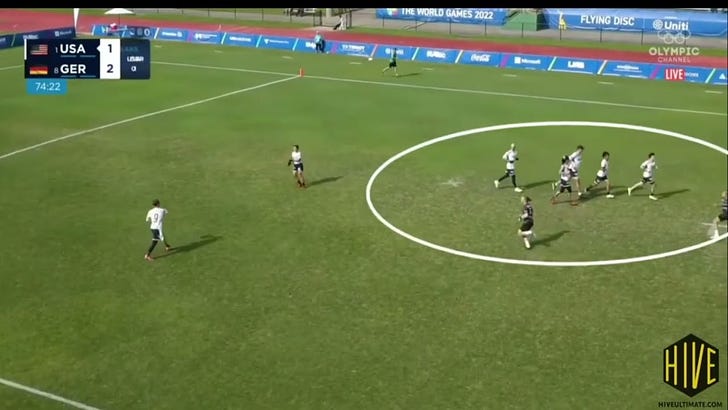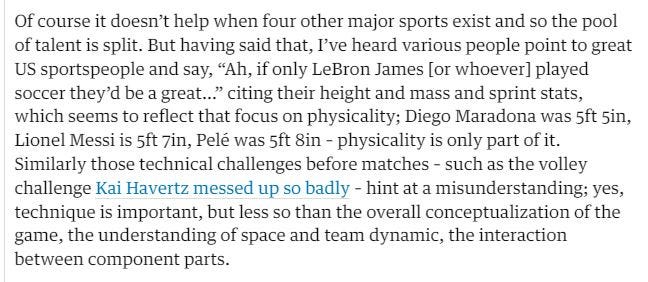I’ve been doing more reading (good) and Youtube watching (not so good) over the past couple of weeks. Here’s a few notes on things that I found interesting.
F.U.S.D
Faking at the thrower is something I did as a player, but usually greeted with skepticism when I try to encourage players to do it. It works! I want to take control of the thrower-marker battle whichever side of that equation I’m on. You won’t win many reactive battles against a good thrower.
Different Types of Athleticism
Also from Seven Seconds or Less this section on Steve Nash’s athleticism had me thinking for a while. A lot of the most unguardable players in sports aren’t measurably the most athletic. It’s very tempting to reduce athleticism to it’s testable components - particularly isolating one aspect like acceleration or jumping. So I loved Nash’s comment here that when he’s on the move - which involves multiple different components - he has an advantage.
There is way too much focus on drilling movement from static in Ultimate. Cutting drills from static positions, reset drills from static positions. You do of course need to be prepared for those situations but I firmly believe that always teaching these skills in that environment makes for worse handlers and cutters. Most of the best handlers are free all the time - because they never stop moving. Similarly watch the progression of the disc through cutters and check how often cutters actually need to fake to get open versus how often they get open from movement and timing and coordination…and then think about if your training is in line with that ratio.
Skills
It’s so simple to reduce players to a computer game style list of graded attributes - what’s their rating for speed, jumping, forehand, cutting, etc. But none of these are actually happening in isolation in a game. Players are not a collection of attributes. There are many, many intangibles that make a player effective or not so effective.
(I need to say again - I don’t think the way most teams train supports the development of those intangibles)
Deep Cuts from Shallow in Vertical Stack
Hive Ultimate went through every turnover in the Germany - USA game from World Games last year - a surprisingly mammoth task as this was far from a clean game. I encourage you to go watch the full video.
This is a good breakdown of the turnover and highlights a common sequence in vertical stack offence - a long cut from shallow is almost impossible for the defence to not be distracted by.
This is something you can use to your advantage on offence - sending a deep cut that is asking the defence to try and switch or double it. If the defence doesn’t do that perfectly you’ve created a great opportunity somewhere. It’s something I’ve used heavily in the past to initiate play. I’m particularly fond of the 1-2 punch of sending the front of stack deep then next point isolating them in the short space - or vice versa.
I wrote in my notes on the EUC Women’s Final, GB used this concept a lot in the first half, sending Hannah Yorwerth deep after fielding the pull.
One part I didn’t include in my notes then was you can see the back of the stack peel off Rachel Naden to help on Yorwerth’s strike. Unfortunately Naden seems distracted trying to remind another cutter to move - when Naden is now clearly is the best option.
Naden is then completely free a split second later - her defender is offscreen. GB still manage to complete the throw to space here with a fantastic forehand from Hannah Brew, but this could have been even simpler.
Relationist vs Structural Football Tactics
Football tactics are currently dominated by ‘positional play’, which is essentially where the coach dictates in advance the exact zones on the pitch they want occupied. This, combined with designed patterns of ball movement, create spaces that the team can use to attack. This is of course best seen with Pep Guardiola’s teams, and his success has seen these ideas become the standard way to play.
‘Relationist’ tactics reject this approach and have become the darling of the football blogger world in recent months. Relationism eschews maintaining a structure or creating space in favour of using combinations between players to advance the ball and create attacks. Players have seemingly complete freedom to go where they want and are trusted to create patterns of play out of this chaos. Although there are clear repeated patterns of how they solve these problems it still relies a lot more on the quick-thinking and creative solutions than in positional play, where the options are known and defined by the coach ahead of time.
What does any of this have to do with Ultimate? Well, one thing is that I was struck by how similar parts of this philosophy were to what Jonny Malks and Rowan McDonnell described when talking about Truck Stop’s offence on their podcast earlier this year. Secondly, I think it’s a good lens to look at offence through - how much of your offence relies on structure vs. how much relies on combinations between players? There’s no right or wrong answer to that, but if you don’t know where you fall on that scale it’s going to be a lot more difficult to respond to challenges throughout the season. For me as a coach finding those pockets of chemistry between players has always been key to success - one of the reasons for Ranelagh’s below par early season performance last year is that we were intentionally experimenting to figure out those combinations.
(also to sound like a broken record - if you train through static situations and have a fixed line setup you’ll never create or discover these combinations)









The tactics of the Relationists remind me a bit of the way Revolution (COL) approaches Ultimate.
Ju